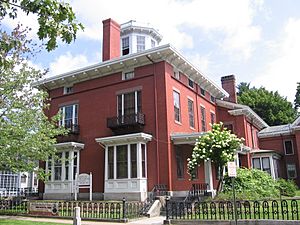Skolfield–Whittier House facts for kids
The Skolfield–Whittier House is a special museum in Brunswick, Maine. It's like a "time capsule" because it looks almost exactly as it did during the Victorian era. This means it's full of old furniture and items from a long time ago! The house is located at 161 Park Row and is managed by the Pejepscot Historical Society.
Contents
The Skolfield Family and Their Home
The Skolfield–Whittier House was built between 1858 and 1862. It was originally one half of a large, two-family home called a duplex. This duplex was built for the sons of a rich shipbuilder named George Skolfield.
Building a New Home
Captain Alfred Skolfield (1815–1895) owned the side that is now the Skolfield–Whittier House. He shared the building cost with his brother, Captain Samuel Skolfield. Samuel lived in the other half of the duplex, which is now the main office for the Pejepscot Historical Society.
In 1862, Alfred, his wife Martha Harward, and their young daughter Eugenie moved into their new home. They bought fancy furniture from Portland, Maine, in a style called Rococo Revival. Many of these original pieces are still in the house today! The home also had beautiful marble fireplaces and stylish curtains. Back then, the house was likely lit by gaslight. In 1864, Alfred and Martha had another daughter, Augusta Marie.
A Trip to England
In 1867, the Skolfield family moved to Liverpool, England. The exact reason isn't fully clear. It might have been because of political tensions in the United States after the Civil War. The Skolfields were Democrats, but they lived in an area that was mostly Republican.
Even though they moved, they didn't sell their Brunswick home. Instead, they rented it out to different people. They had renters like Professor J.B. Sewall and Dr. Mitchell during their time away.
Returning Home and Renovations
After 18 years in England, the Skolfields returned to their Brunswick home in 1885. They immediately started making changes! They updated the plumbing and connected the old carriage house to the main building. This new space became the kitchen, an informal dining room, and the laundry room. The old kitchen was turned into a formal dining room, and the old dining room became a "drawing room," which was a fancy living room.
The family brought many new decorations from England, showing how their time abroad influenced their style. They bought new carpets, a piano, and several paintings. They also updated their furniture with pieces in the popular Eastlake style. In 1891, the house got electricity, and around 1894–1895, it was connected to the town's new sewer system.
The Whittier Family Takes Over
Alfred Skolfield passed away in 1895. Soon after, his daughter Eugenie married Frank Whittier (1861–1924) in the drawing room. Frank was a very smart doctor who graduated from Bowdoin College. He became a professor of Pathology and Bacteriology at the Maine Medical School.
Frank Whittier was Maine's first forensic pathologist. This means he was a doctor who helped solve crimes by studying medical evidence. He was also the first medical examiner for Cumberland County. He even developed new ways to test blood and match bullets to guns, which were important for court cases.
Life with the Whittiers
Frank and Eugenie didn't change the house much. Frank added a grandfather clock to the entrance hall. Around 1910–1912, they moved their main bedroom to the former carriage house. The old main bedroom became the library. By 1913, a telephone was installed in the home.
Eugenie and Frank had three daughters: Isabel, Alice, and Charlotte. Sadly, Charlotte died young. Isabel became a teacher at Brooklyn College and was a close friend of a famous politician, Margaret Chase Smith. Alice followed in her father's footsteps and became Maine's first female pediatrician, a doctor who specializes in children's health.
After Frank's death in 1924, Eugenie loved to travel. She and her daughters usually only spent summers at their Brunswick home. In 1982, Alice, who was the last living family member, gave the entire house and everything inside it to the Pejepscot Historical Society. Today, you can visit the museum for guided tours during the summer.



